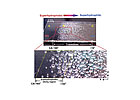

Wetability gradient: Water sprayed on a glass slide coated
with a nanostructured gradient wetability film using the new NIST technique
illustrates the transition from (A) superhydrophobicity to (C)
superhydrophilicity. The lower image shows the magnified image of the (A)
hydrophobic to (B) transition wetting region. The pink dotted line indicates
the border of the superhydrophobic region, and the yellow dotted region shows a
hydrophobic ‘sticky’ region. Photo courtesy of NIST.
The NIST team developed a flexible technique, based on ultraviolet light and photosensitive materials, to mimic one of nature’s cleverest feats of surface chemistry. The Stenocara beetle of Africa’s Namib Desert is able to thrive in a habitat so parched that not even the morning fog will condense. All the beetle has to do is raise its warty-looking wing covers into the breeze. Because the bumps are hydrophilic (water-attracting) while the rest of the surface is hydrophobic (water repelling), the few water molecules that do strike the wing covers tend to get pushed uphill and collect on the bumps - where they eventually condense into artificial dewdrops that roll into the insect’s mouth. The insect’s trick is to use both surface structure and chemistry to create a surface that shifts rapidly from hydrophobic to hydrophilic.
The NIST researchers began by coating the surface with a matrix of silica granules about 11 nanometers across. As with the beetle, whose wing covers are coated with organic particles about a thousand times larger, the spacing of the matrix provides a first, purely physical level of control over wetability: a water droplet placed on top of the granules can sag only a certain distance into the gaps before it is stopped by surface tension.
The researchers then added a second level of control by coating the granules with a compound that changes the water affinity, similar to how a waxy substance makes some of the beetle’s microparticles hydrophobic. This step in itself is not unique; other research groups have added such compounds to granular surfaces using electrochemical techniques. The NIST group, however, used an optical technique that is much easier to modulate, and that can be carried out in air. They simply coated the granules with a photo-sensitive material and exposed it to ultraviolet light; the longer and more intense the exposure was in a given area, the more hydrophilic that area became.
The most immediate application for this new technique is for testing of adhesives and coatings; instead of daubing the compounds on dozens of surfaces one by one, researchers can now spread them over a single surface that tests the entire range of wettability within the space of a few centimeters. Other possible applications range from water collection in dry regions to open-air microchannel devices. Indeed, the same technique can be used to create surfaces that vary in their affinity for alcohol and many other small molecule liquids.
Source: The National Institute of Standards and Technology (NIST)
For more information, contact NIST at, www.nist.gov.